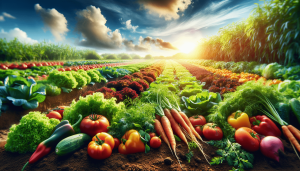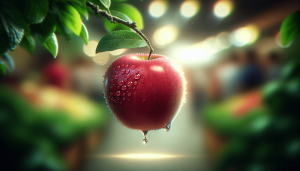Introduction to Organic Greens
Have you ever found yourself stuck in the vegetable aisle, staring at all the green stuff, wondering what all the fuss is about? If you’re like me and think that a vegetable garden is a place where plants go to party, then organic greens might be a concept that’s slightly foreign to you. But worry not! Let’s embark on a journey to explore the world of organic greens
What Are Organic Greens?
Organic greens are the Gandalf of the vegetable world, the wisest and most natural of them all. And no, they don’t come with a staff and a pointy hat. These greens are grown without the use of synthetic chemicals like pesticides and fertilizers. They are cultivated in a way that nourishes the soil, respects the ecosystem, and doesn’t rely on any artificial means to boost growth or appearance.
Here’s the magic spell behind it:
- No Synthetic Chemicals: Organic farmers use natural methods to fend off pests and feed the soil. This means no harmful residue on your spinach, and no, you don’t have to worry about your salad biting back.
- Soil Health: Organic farming is like a spa treatment for the earth. By using natural fertilizers and rotating crops, farmers keep the soil happy, healthy, and ready to produce the next crop of delicious greens.
- Non-GMO: Organic greens are not genetically modified. If you’re looking for greens that haven’t been tinkered with in a lab, organic is the way to go.
- Local Love: Many organic greens are grown locally, meaning fresher produce for you and less impact on the environment. Think global, eat local!
- Ethical Treatment: Organic farming often goes hand-in-hand with the ethical treatment of workers and animals. Happy cows, happy farmers, happy salad!
Benefits of Organic Greens
Organic greens are not only a treat for your taste buds but also pack an impressive list of benefits that extend beyond the kitchen. Here’s the nitty-gritty of why you might want to make organic greens a mainstay in your diet.
Environmentally Friendly: Mother Earth’s BFF
Organic greens are like superheroes for the planet. By saying no to synthetic pesticides and fertilizers, they reduce pollution and conserve water. Organic farming practices also encourage soil health and reduce erosion. Imagine if the Earth had a Facebook page; organic greens would definitely be in its top friends list.
- Reduces Pollution: Without synthetic chemicals, there’s less toxic runoff entering our water systems.
- Promotes Biodiversity: Organic farms are like animal parties, attracting a variety of wildlife.
- Reduces Soil Erosion: By practicing crop rotation and using cover crops, organic farming protects the precious soil.
Nutrient-Rich:
Some studies suggest that organic greens might be more nutrient-rich compared to their conventionally grown counterparts. Think of them as the spinach to your inner Popeye.
- Vitamins and Minerals: Organic greens often contain higher levels of certain vitamins and minerals, giving you more bang for your nutritional buck.
- Antioxidants: More antioxidants? Yes, please! These are compounds that fight off those nasty free radicals in your body.
- Better Taste: Many people swear that organic greens taste better. Fresher, more robust flavors can be a delightful experience for your palate.
Non-GMO: Keeping It Real
Organic greens are like genuine friends who’ve never had any “work done.” They are not genetically modified, so what you see is what Mother Nature intended.
- Avoiding Unknown Risks: While the debate on GMOs continues, some prefer to stay on the safe side by choosing organic.
- Preserving Natural Integrity: Organic farming respects the plant’s natural genetic structure, celebrating diversity in our food.
Supports Local Farmers: Your Neighborhood Heroes
When you buy organic greens, you’re often supporting local farmers who are committed to sustainable practices. It’s like giving your neighbor a high-five every time you crunch on a piece of lettuce.
- Boosting Local Economy: Money spent on local organic produce stays in the community, strengthening the local economy.
- Connecting with Your Food: Knowing where your food comes from and who grows it can create a deeper connection to your meals and the people who make them possible.
Health Benefits: Your Body’s Best Bud
Last but certainly not least, organic greens can be a boon to your health. No synthetic pesticides mean less risk of exposure to potential toxins.
- Less Exposure to Chemicals: Minimizing exposure to synthetic chemicals can be part of a healthy lifestyle choice.
- Dietary Variety: With a plethora of organic greens available, you can enjoy a diverse diet that offers a wide range of nutrients.
Types of Organic Greens Available
If you think all greens are created equal, it’s time to leaf through the delectable selection of organic greens. From salad staples to exotic additions, the world of organic greens is a veritable garden of gastronomic delights. Let’s take a stroll through the aisles and meet these green wonders!
Kale: The Ironclad Superleaf
Kale has made a name for itself as the poster child of health foods, and for good reason! This leafy powerhouse is rich in vitamins A, K, and C, along with iron and calcium.
- Curly Kale: With ruffled leaves, this variety adds texture and a mild peppery flavor.
- Lacinato Kale: Also known as Dinosaur Kale, it has dark, bumpy leaves and a slightly sweeter taste.
- Serving Ideas: From salads to smoothies, kale can be enjoyed raw or cooked, sautéed, or even turned into crispy chips.
Spinach: Popeye’s Pride
Popeye wasn’t kidding when he touted the benefits of spinach. This versatile green is loaded with vitamins, minerals, and iron, ready to power up your meals.
- Baby Spinach: Tender and sweet, perfect for salads or wilting into warm dishes.
- Mature Spinach: Hearty leaves suitable for sautés, soups, or stuffing.
- Serving Ideas: Enjoy it fresh in salads or sandwiches, cooked in omelets, or blended in a green smoothie.
Arugula: The Peppery Party Starter
Arugula, with its distinctive peppery kick, adds a bold touch to your culinary creations.
- Wild Arugula: More intense in flavor, this variety loves to make a statement.
- Garden Arugula: Milder and tender, it’s the perfect addition to mixed green salads.
- Serving Ideas: Toss it with lemon and olive oil for a simple salad or use it as a zesty pizza topping.
Collard Greens: The Soul Food Star
A staple in Southern cooking, collard greens are rich in vitamins and minerals, with a hearty texture that can stand up to cooking.
- Serving Ideas: Often simmered with ham hocks or bacon, they’re the centerpiece of a comforting meal. Try them in wraps for a healthy twist!
Chard: The Rainbow in Your Bowl
Chard’s vibrant stems and tender leaves are not only a feast for the eyes but also packed with nutrients.
- Rainbow Chard: A colorful mix of red, yellow, and white stems that brighten any dish.
- Swiss Chard: Dark green leaves with a mild, earthy flavor.
- Serving Ideas: Sauté with garlic and olive oil, add to soups, or use the raw leaves for wraps.
Lettuce: The Salad Sovereign
Lettuce reigns supreme in the world of salads, offering a crisp and refreshing base for endless combinations.
- Romaine Lettuce: Crunchy and robust, ideal for Caesar salads.
- Butterhead Lettuce: Soft, buttery leaves that melt in your mouth.
- Iceberg Lettuce: Crisp and refreshing, perfect for adding a crunch to sandwiches.
- Serving Ideas: Use in salads, wraps, or even grill for a smoky flavor.
Growing Organic Greens at Home
Who says you need a farm to grow organic greens? Whether you have a sprawling garden or just a sunny windowsill, growing organic greens at home can be a fun, rewarding, and tasty adventure. Let’s dig in!
Choosing the Right Location: Location, Location, Vegetation
The first step in your gardening quest is picking the perfect spot. Consider these points:
- Sunlight: Greens love to sunbathe. Ensure your chosen location gets at least 6 hours of sunlight a day.
- Soil Quality: Good soil is like a five-star hotel for plants. Rich, well-draining soil makes for happy greens.
- Space: Whether you have a garden, a balcony, or just some pots on a windowsill, choose a spot that allows your greens to stretch their leaves.
Selecting the Seeds: The Ultimate Dating Profile
Choosing seeds is like scrolling through a dating app for plants. Look for qualities that match your preferences and growing conditions.
- Variety: From kale to spinach, choose varieties that you love to eat and that suit your climate.
- Organic Seeds: Opt for certified organic seeds to ensure your greens start life without any synthetic chemicals.
- Compatibility: Some greens play well together. Companion planting can deter pests and boost growth.
Soil Preparation: Pampering Your Plant Babies
Think of soil preparation as setting up a cozy nursery for your future plant babies.
- Testing: Get to know your soil. Testing for pH and nutrient levels helps tailor the perfect environment.
- Composting: Adding organic compost enriches the soil, providing a buffet of nutrients.
- Tilling: Loosening the soil helps the roots spread out and dance to their heart’s content.
Planting: The Birth of Green Dreams
Planting day is like the grand opening of your green dreams.
- Spacing: Give your plants room to breathe. Proper spacing encourages healthy growth.
- Depth: Plant seeds at the right depth, usually around twice the seed’s diameter.
- Watering: Water gently to settle the soil, singing lullabies is optional but encouraged.
Caring and Maintenance: A Green Thumb’s Diary
Being a plant parent requires love, attention, and a bit of elbow grease.
- Watering: Keep the soil moist but not soggy. Nobody likes wet feet, even plants.
- Weeding: Show those pesky weeds who’s boss. Regular weeding ensures your greens get all the nutrients.
- Pest Control: Use natural methods like neem oil or introduce beneficial insects like ladybugs.
Harvesting: The Salad Bowl Victory Lap
Harvesting is the victory lap of your gardening journey. Grab your salad bowl; it’s time to feast!
- Timing: Harvest when leaves are tender and flavorful, usually in the morning.
- Technique: Snip leaves carefully to encourage new growth. Thank your plants for their bounty; they’ve worked hard.
- Storing: Keep freshly harvested greens in the fridge or eat immediately for a farm-to-fork experience.
Buying Organic Greens
Buying organic greens doesn’t have to be a wild goose chase through the grocery aisles. With a little know-how, you can make informed, delicious, and earth-friendly choices. Here’s your comprehensive guide to buying organic greens that make both your wallet and your taste buds happy.
Understanding Labels: Deciphering the Organic Code
Labels can be confusing, but here’s how to crack the code:
- Certified Organic: Look for official certification logos, such as USDA Organic in the United States. This ensures that the greens are grown without synthetic pesticides and meet specific standards.
- Local Organic: Sometimes local farmers follow organic practices but aren’t officially certified. Chatting with them at farmers’ markets can give you insights into their methods.
- Natural Doesn’t Mean Organic: Be cautious! The term “natural” is not regulated and doesn’t guarantee organic practices.
Choosing Fresh Greens: A Fresh Perspective
Selecting fresh organic greens is like picking the lead dancer for your culinary ballet. Here’s what to look for:
- Color and Texture: Vibrant color and crisp texture are good indicators of freshness. Your greens should look like they’ve just had a spa day.
- Sniff Test: Fresh greens often have a pleasant, earthy aroma. If it smells like a garden in spring, you’re on the right track.
- Avoid Wilted Leaves: If the greens look like they’ve just run a marathon, it’s best to leave them on the shelf.
Considering Seasonality: Sync with Nature’s Calendar
Buying in season is like riding nature’s rhythm. Here’s why it’s worth it:
- Taste: Seasonal greens taste like they’ve been kissed by the sun. Their flavor is often at its peak.
- Nutrition: When harvested in their prime season, greens may contain more nutrients.
- Environmental Benefits: Seasonal produce often requires less energy to grow and transport. It’s like giving the planet a little hug with every bite.
Exploring Local Options: Support Your Green Neighbors
Local organic options are like the friendly neighbors of the produce world.
- Farmers’ Markets: These community gems are great places to meet local farmers and ask about their practices.
- CSA Programs: Community Supported Agriculture (CSA) allows you to subscribe to a local farm’s harvest. It’s like getting a weekly goodie box from Mother Nature.
- Local Grocery Stores: Many stores highlight local produce. Look for signs or ask staff for local options.
Comparing Prices: Your Wallet’s Best Friend
Organic greens don’t have to break the bank. Here’s how to shop smart:
- Buy in Bulk: If you eat a lot of greens, consider buying in bulk to save some greenbacks.
- Seasonal Sales: Keep an eye on sales and promotions, especially for in-season produce.
- Generic Organic Brands: Some store brands offer organic options at a friendlier price.
The Future of Organic Greens
The world of organic greens is evergreen (pun intended!), constantly evolving, and promising a vibrant future. Let’s take a journey into the crystal ball of organic greens and see what’s budding on the horizon.
Sustainable Farming Practices: Going Green Gets Greener
- Regenerative Agriculture: Beyond just doing no harm, regenerative practices aim to actively improve soil health, water retention, and biodiversity.
- Water Efficiency: New irrigation techniques are focusing on conserving water, a critical resource.
- Renewable Energy: Integrating solar, wind, or bioenergy to power farms adds another layer of environmental responsibility.
Technology Integration: Farming Gets Smart
- Precision Farming: Drones, sensors, and AI allow farmers to monitor and respond to individual plant needs, optimizing resources.
- Vertical Farming: Urban vertical farms can grow organic greens in controlled environments, reducing the need for transportation and offering city dwellers farm-fresh produce.
- Lab-Grown Options: Though still in early stages, lab-grown organic greens might become a reality, providing sustainable alternatives without traditional farming.
Consumer Awareness and Engagement: Power to the Eaters
- Traceability: QR codes and apps can trace a product back to its farm, providing transparency and connection between farmers and consumers.
- Local Food Movements: The rise in farmers’ markets and CSA programs indicates a growing desire to support local and sustainable food systems.
- Education and Outreach: From schools to community gardens, educating the public about organic farming’s benefits is fostering a new generation of conscious consumers.
Global Collaboration and Regulation: Green Diplomacy
- International Standards: Harmonizing organic standards across countries can facilitate trade and ensure quality.
- Climate Agreements: Organic farming’s role in mitigating climate change may become part of global environmental strategies.
- Public-Private Partnerships: Collaboration between governments, NGOs, and businesses can drive innovation and promote organic practices.
Diversification and Accessibility: Greens for All
- New Varieties: Research into diverse and climate-resilient crops will enrich our plates and ecosystems.
- Affordability: Initiatives to make organic greens more affordable and accessible to all income levels are vital for inclusive growth.
- Therapeutic Uses: Research into the medicinal properties of greens may open new doors in healthcare and wellness.
Conclusion: A Thriving Organic Horizon
The future of organic greens is blooming with opportunities, innovations, and connections. From the soil to the supermarket, every aspect of the organic green life cycle is ripe for transformation and growth. As technology, ethics, and creativity intertwine, the road ahead promises a richer, tastier, and more sustainable food landscape. Whether you’re a farmer, a foodie, or just someone who loves a good salad, the future of organic greens invites you to be part of a nourishing and exciting journey.
FAQs
What are the best types of organic greens to grow at home? The best types to grow at home are those that thrive in your local climate, like spinach, kale, or arugula.
How can I be sure that the greens I buy are genuinely organic? Look for the USDA Organic label or buy from a trusted local farmer who can verify their organic practices.
Do organic greens really taste better? Many people believe they do, but it might be a matter of personal preference. Try a taste test and decide for yourself!
Are organic greens more expensive? They can be, but growing your own or buying in season can help offset the cost.
How do I store organic greens to keep them fresh? Keep them in the crisper drawer of your fridge, wrapped in a damp cloth or in a container designed to keep greens fresh. That way, they’ll stay crisp and delicious, ready for your next culinary adventure.




